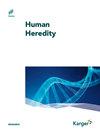Influence of Estrogen Receptor Alpha Polymorphism on Bone Mineral Density in Iranian Children
IF 1.5
4区 生物学
Q4 GENETICS & HEREDITY
引用次数: 5
Abstract
Background: Bone mass acquisition in childhood is directly linked to adult bone mineral density (BMD) and fracture risk. BMD is a heritable trait, more than 70% of its variability among a population is affected by genetic factors. Objectives: In the present study, we wanted to investigate the association between estrogen receptor alpha (ESR1) polymorphisms, PvuII (rs2234693) and XbaI (rs9340799), and bone area, bone mineral content (BMC), and BMD of the lumbar spine, femoral neck, and also of the total body less the head in Iranian children. Methods: The ESR1 gene PvuII and XbaI genotypes were determined by polymerase chain reaction-restriction fragment length polymorphism. Bone area, BMC, BMD, and bone mineral apparent density (BMAD) were assessed by dual-energy X-ray absorptiometry (DEXA). Linear regression was carried out to examine the effects of the ESR1 (PvuII and XbaI) polymorphisms on DEXA outputs when adjusted for confounding factors (i.e., age, sex, BMI, and pubertal stage) in 3 models. Results: ESR1 (PvuII) gene polymorphisms (CT vs. CC) showed significant effects on the BMC of the total body less the head in all 3 models. For ESR1 (XbaI), individuals with the AG genotype had higher lumbar spine BMD and lumbar spine BMAD compared to other genotypes. Conclusions: It seems that the PvuII and XbaI polymorphisms of ESR1 could be associated with BMC and BMD variation in Iranian children and adolescents.雌激素受体α多态性对伊朗儿童骨密度的影响
背景:儿童期骨量获取与成年期骨密度(BMD)和骨折风险直接相关。骨密度是一种可遗传的性状,其在人群中的变异有70%以上受遗传因素的影响。目的:在本研究中,我们希望研究伊朗儿童雌激素受体α (ESR1)多态性、PvuII (rs2234693)和XbaI (rs9340799)与腰椎、股骨颈以及全身除头部外的骨面积、骨矿物质含量(BMC)和骨密度之间的关系。方法:采用聚合酶链反应-限制性片段长度多态性检测ESR1基因PvuII和XbaI基因型。采用双能x线吸收仪(DEXA)评估骨面积、BMC、BMD和骨矿物质表观密度(BMAD)。在3个模型中,采用线性回归检验ESR1 (PvuII和XbaI)多态性在校正混杂因素(即年龄、性别、BMI和青春期)后对DEXA输出的影响。结果:ESR1 (PvuII)基因多态性(CT vs. CC)对3种模型的全身除头部BMC均有显著影响。对于ESR1 (XbaI),与其他基因型相比,AG基因型个体具有更高的腰椎BMD和腰椎BMAD。结论:ESR1的PvuII和XbaI多态性可能与伊朗儿童和青少年的BMC和BMD变异有关。
本文章由计算机程序翻译,如有差异,请以英文原文为准。
求助全文
约1分钟内获得全文
求助全文
来源期刊

Human Heredity
生物-遗传学
CiteScore
2.50
自引率
0.00%
发文量
12
审稿时长
>12 weeks
期刊介绍:
Gathering original research reports and short communications from all over the world, ''Human Heredity'' is devoted to methodological and applied research on the genetics of human populations, association and linkage analysis, genetic mechanisms of disease, and new methods for statistical genetics, for example, analysis of rare variants and results from next generation sequencing. The value of this information to many branches of medicine is shown by the number of citations the journal receives in fields ranging from immunology and hematology to epidemiology and public health planning, and the fact that at least 50% of all ''Human Heredity'' papers are still cited more than 8 years after publication (according to ISI Journal Citation Reports). Special issues on methodological topics (such as ‘Consanguinity and Genomics’ in 2014; ‘Analyzing Rare Variants in Complex Diseases’ in 2012) or reviews of advances in particular fields (‘Genetic Diversity in European Populations: Evolutionary Evidence and Medical Implications’ in 2014; ‘Genes and the Environment in Obesity’ in 2013) are published every year. Renowned experts in the field are invited to contribute to these special issues.
 求助内容:
求助内容: 应助结果提醒方式:
应助结果提醒方式:


